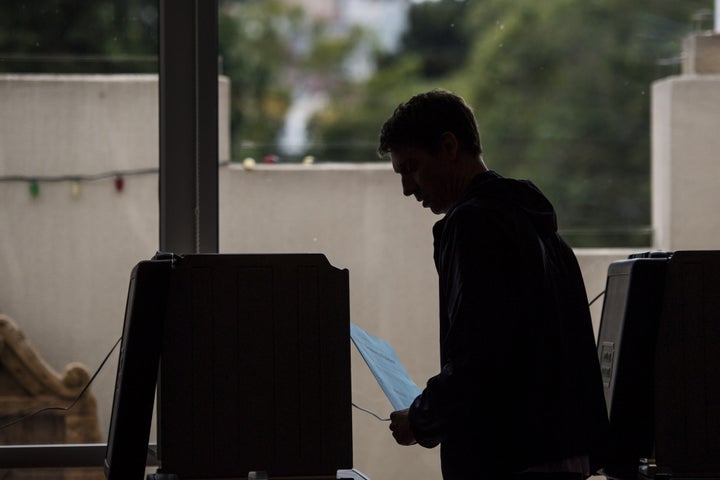
In a 2010 ballot initiative, Californians voted to adopt a new primary system. Rather than each party conducting a separate nomination race and having those winners proceed to the general election in November, candidates from all parties in the state compete together in a single contest ― a so-called “jungle primary.” The top two vote-getters then square off against one another in the general election, no matter which party they’re from.
This unusual system has already resulted in a number of federal races without a Republican candidate at all, most notably in 2016 when Democrats Kamala Harris and Loretta Sanchez were the only two major party candidates on the general election ballot for a Senate seat. But this year, with the focus on a number of pivotal House races, it could be Democrats who get burned.
The ballot initiative was backed mostly by then-Gov. Arnold Schwarzenegger (R) and some key business players, and was opposed by the left, including the state’s powerful teachers union, as well as by the leaders of both the Democratic and Republican parties. Its boosters wanted to send more moderate politicians to Sacramento, presumably ones who would enact corporate-friendly policies into law. Some reformists believed it might also increase the typically abysmal turnout for primaries.
The limited academic research on the jungle primary system suggests it is failing at both of these goals. Turnout declined in the first two statewide primaries held under the top two rules. In particular, the reform does not seem to boost the fortunes of more moderate candidates, because as one 2013 study found, primary voters, especially when faced with a multitude of candidates, “failed to discern ideological differences between extreme and moderate candidates of the same party.”
Those are the problems from the perspective of democratic theory. But for California Democrats in 2018, the reform has another obvious vulnerability, a Death Star backdoor big enough to fly a dozen X-Wing Starfighters through: If too many candidates from one party are running in the primary, they can split their party’s voters several ways and allow the other party to win the top two spots with small pluralities.
Democrats who once salivated at the prospect of excluding GOP candidates altogether might now get hoisted on their own petards with this very problem in the state’s June 5 primary. In several districts that Democrats hoped to flip or that would otherwise be total gimmes for the party, there are so many people running for Team Blue that voters might not be able to coalesce around two or even one. One such seat is that of Rep. Dana Rohrabacher, in California’s 48th district, where eight Democrats are vying for the chance to replace the unpopular Republican. It’s possible that none of the eight will finish in the top two spots.

Despite the panicked intervention of national Democrats, not enough candidates have gotten out of these races to avoid the worst outcome. With Democrats locked in a bitter battle to wrest control of the House from a venal GOP majority bent on protecting President Donald Trump at all costs, this is a nightmare scenario for the party. They can ill afford to toss away a single winnable seat due to too-clever-by-half electoral rules.
There are two very simple ways out of the mess created by the top two primary system. The first would be to toss it in the trash and go back to the old method of conducting separate partisan primaries for Democrats and Republicans, a system for which turnout failings could be better addressed with reforms like election holidays and the state’s new automatic voter registration laws.
Failing a return to the old order, Californians interested in more democratic elections need to mobilize behind a new ballot initiative to conduct all top two primaries using ranked-choice voting. With this method, voters can rank-order their preferred candidates. If their first choice is eliminated, their ballot is not thrown away but rather redistributed to their second choice candidate, or the third choice, and so on.
This system, which is how Ireland elects its parliament and has been adopted by a number of U.S. cities for local elections, would make it possible for a large field of energized Democratic candidates to compete against one another without fearing that they will so dilute the vote as to make Republicans the top two in districts that should be competitive. Ranked-choice voting would also give voters a chance to vote their hearts, perhaps for a candidate from outside of the two-party system altogether, without worrying about wasting their votes.
California is not the only place where ranked-choice voting would save voters time and potential anguish. Last year we saw the spectacle of Republicans in Alabama holding two separate primaries for a special election. The first, which took place on Aug. 15, failed to resolve matters since Alabama’s law requires a candidate to get 50 percent of the vote to proceed to the general election or else face a subsequent runoff.
Alleged child molester and two-time Alabama Supreme Court evictee Roy Moore was then pitted against sitting Sen. Luther Strange in yet another Republican primary election on September 26. Finally, after Moore won that race, the weary citizens of Alabama were called to the ballot for a third time on the profoundly strange date of Dec. 12, when they narrowly sent Democrat Doug Jones to the Senate.
It would be difficult to overstate how bananas all of this is when clever institutional designers long ago invented a way to perform runoff elections instantaneously. For single-winner races like a Senate primary, all Alabama would have to do is use ranked-choice voting to produce a single winner with majority support. Votes can be sorted and tabulated in seconds with digital voting machines, or if you prefer the safety and security of analog tabulation, it wouldn’t take much longer. Voters wouldn’t have to show up for two separate elections that are already marred by low turnout.
Regardless of what happens on June 5, California should take the lead once again on electoral reform by becoming the first state to use ranked-choice voting for any part of a statewide federal election. Once voters see that preferential voting can work in the primaries, they may be more willing to entertain the idea of using this method to elect the entire House, a reform that would open up the political process to third parties, as a majority of Americans say they desire.
David Faris is an associate professor of political science at Roosevelt University in Chicago, a contributing writer at The Week and the author of It’s Time to Fight Dirty: How Democrats Can Build a Lasting Majority in American Politics, from Melville House Publishing.
